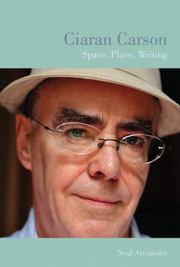Book contents
- Frontmatter
- Contents
- Acknowledgements
- Abbreviations
- Introduction
- Chapter 1 Imaginative Geographies: The Politics and Poetics of Space
- Chapter 2 Mapping Belfast: Urban Cartographies
- Chapter 3 Deviations from the Known Route: Reading, Writing, Walking
- Chapter 4 Revised Versions: Place and Memory
- Chapter 5 Spatial Stories: Narrative and Representation
- Chapter 6 Babel-babble: Language and Translation
- Bibliography
- General Index
- Index of Works
Chapter 2 - Mapping Belfast: Urban Cartographies
- Frontmatter
- Contents
- Acknowledgements
- Abbreviations
- Introduction
- Chapter 1 Imaginative Geographies: The Politics and Poetics of Space
- Chapter 2 Mapping Belfast: Urban Cartographies
- Chapter 3 Deviations from the Known Route: Reading, Writing, Walking
- Chapter 4 Revised Versions: Place and Memory
- Chapter 5 Spatial Stories: Narrative and Representation
- Chapter 6 Babel-babble: Language and Translation
- Bibliography
- General Index
- Index of Works
Summary
In the discourse of cultural theory it seems that there is considerable confusion, or at least deep ambivalence, concerning the status and function of maps and mapping. In this context it is important to note that mapping tends to be treated by cultural theorists less in terms of its specific histories and methodological principles than as a set of concepts that are often employed in explicitly metaphorical ways – ‘mapping’, then, rather than strict cartography. On the one hand, there is a tendency to equate mapping with the apparatuses of the state and of social control, as a sort of graphic inscription of panoptic authority that is imposed upon the territory. Certainly, the historical and strategic importance of charts, maps, and plans in the expansion of European imperialism plays a large part in determining this view. For instance, David Harvey observes that ‘the mapping of the world opened up a way to look upon space as open to appropriation for private uses. Mapping also turned out to be far from ideologically neutral.’ Similarly, Doreen Massey discusses maps as ‘ordering representations’ that operate as a ‘technology of power’ by stabilising the co-ordinates of time-space and constructing the geographical territory as ‘a coherent closed system’. This question of closure or delimitation is crucial, for the widespread suspicion of cartography on the part of cultural theorists is arguably also symptomatic of a more widespread, and loosely post-structuralist, distrust of totalisations and grand narratives.
- Type
- Chapter
- Information
- Ciaran CarsonSpace, Place, Writing, pp. 57 - 84Publisher: Liverpool University PressPrint publication year: 2010



